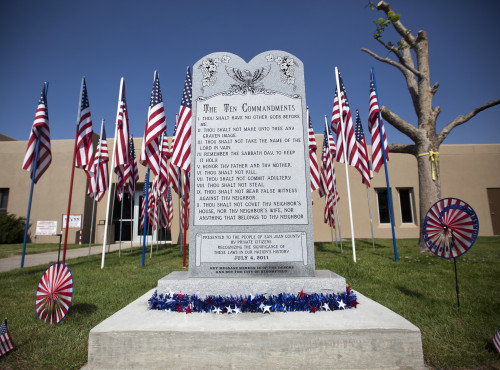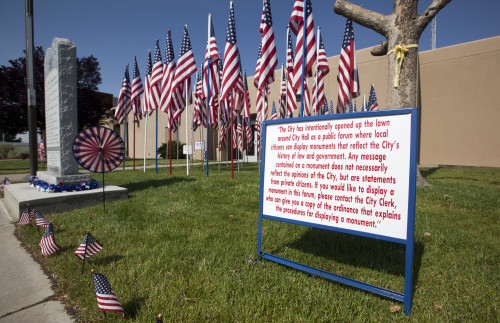WASHINGTON DC — The U.S. Supreme Court has declined to hear a case brought forth by two Pagans concerning the Ten Commandments monument previously erected in front of Bloomfield City Hall. Because SCOTUS declined to hear the case, the 10th Circuit Court of Appeals decision, stating that the monument should be removed, will stand.

©jorndorf/roughshelter.com
Wiccan Priestess Janie Felix and Pagan Buford Coone, with the full support of the ACLU, challenged their home city of Bloomfield’s installation of a Ten Commandants monument on public property in 2014.
The ACLU argued that city officials “accorded preferential treatment to the monument’s sponsors, disregarding many city ordinances and policy requirements that would regulate the monument’s installation.”
Ms. Felix said she is happy the justice system worked in this case and hopes it sets a solid legal precedent for future cases. She says that she is also thankful to the ACLU for their assistance.
“I am grateful for the help and driving force of the ACLU in supporting this important legal fight. I find it sad the the City of Bloomfield was so misguided in this case, money was squandered by the city to pursue the appeals, money that is owed the ACLU for court fees, which they will be hard pressed to pay. It has been hinted that I am to blame!”
History of the Monument
On April 3, 2007, Bloomfield’s Councilor Kevin Mauzy “made a presentation of a monument to display the Ten Commandments in front of Bloomfield City Hall serving as a historical and art display for the city.”
As noted in the official meeting minutes, the proposal was approved and the funds were to come from “private donations from the community.”
In 2014 testimony as reported by The Albuquerque Journal, Mauzy said, “[The monument] was not for religious purposes. It was for historical purposes and to beautify the city.”
After the approval, the Council adopted a resolution permitting private “citizens, groups and organizations” to sponsor displays on City Hall’s lawn. The official resolution outlined the scope and approval process for such an installation. For example one requirement states that all displays must reflect the “history and heritage of the City’s law and government.”
There was an almost immediate outcry from people of many religious backgrounds. At the 2007 meeting, the City Manager urged the Council to delay the monument’s approval until legal concerns were addressed. Opponents spoke at council meetings, sent letters-to-the-editor of local newspapers, and signed petitions. One Bloomfield citizen even launched a blog called “Bloomfield NM Ten Commandments Monument.”
Despite the myriad protests, the monument was erected in June 2011.
The group funding the Ten Commandments monument was the Four Corners Historical Monument Project, which was led by councilor Kevin Mauzy himself. Twenty-one days after the 2011 monument ceremony, the Council amended the 2007 resolution stressing the limits of usable lawn space.
Later that year, the group installed two other monuments, the Declaration of Independence and the Gettysburg Address, within that same space.
The Legal Case
Felix says she wanted to be part of the legal case because the principle of the suit was very important to her.
“The conservative Christian agenda of our community railroaded this monument through, ignoring our petitions, our voices and barreled through as if it was their Deity given right to push their faith and to ignore all others,” says Felix.
She says that she faced considerable negative responses from some in the local community for being part of the lawsuit. In addition to hostile stares when she was in local stores, Felix says there were also threatening comments in the newspaper and on call in radio programs. She says, for the most part, she was able to ignore it.
However, she notes that there was one thing she couldn’t ignore.
“I think the hardest thing to handle was the suggestion that only two Pagans were making everyone else bow to their needs,” says Felix.
She says this wasn’t at all true, “The reality was that the other person and myself had nothing to lose, like our jobs with the city, so we were willing to be the face of the suit. We were the face in front of many who could not come forward.”
The City Council for Bloomfield says that other groups could have funded their own monument to be placed at city hall.
However, opponents say that this isn’t true. They say there isn’t room for any other monuments.
The ACLU was watching the events surrounding the monument unfold since the beginning in 2007. After sending letters-of-concern and launching an investigation, the ACLU finally decided to file a lawsuit on Feb. 9, 2014. According to the filed complaint:
The City of Bloomfield accorded preferential treatment to the monument’s sponsors, disregarding many city ordinances and policy requirements that would regulate the monument’s installation. Public records requests also reveal that Mauzy sought and received legal advice on the monument from the Alliance Defense Fund, an organization that often advocates for the merging of government and religion.
In that complaint, Mr. Coone is recorded as saying the “display shows that the City favors the Christian religion and supports Christianity over other religions [and] … violates the U.S. Constitution and the New Mexico Constitution.” In the same document, Janie Felix says, “[the monument] sends a message of exclusion to those who do not adhere to that particular religion.”
In March 2014, the case went to trial before U.S. District Judge James A. Parker in Albuquerque. Judge Parker ruled in favor of Felix and Coone in August of that year.
The city appealed the decision to the 10th Circuit Court of Appeals in Denver, Colorado, and that case was heard in Sept. 2015.
In November of 2016, the court issued its decision, affirming the lower court’s ruling.

©jorndorf/roughshelter.com
While it did note that the “cluster of other [historically-based] monuments surrounding the Ten Commandments can dampen the effect of endorsement,” the court said, “the city would have to do more than merely add a few secular monuments in order to signal to objective observers a ‘principal or primary’ message of neutrality. Thus the impermissible taint of endorsement remains, and as we have said, nothing sufficiently purposeful, public, and persuasive was done to cure it.”
The city then appealed the decision to the Supreme Court of the United States, who refused to hear the case. A denial of a Petition of Certiorari doesn’t mean SCOTUS agrees or disagrees with the decision or that it will impact any other similar cases, but it does make the decision from the Court of Appeals the final decision in this case.
Felix says everything she went through over the years this case took winding through the legal process was worth it. “I was aware that it could take a long time to get through all the step,” she says. “And, yes, I would definitely do it again!”
The Wild Hunt is not responsible for links to external content.
To join a conversation on this post:
Visit our The Wild Hunt subreddit! Point your favorite browser to https://www.reddit.com/r/The_Wild_Hunt_News/, then click “JOIN”. Make sure to click the bell, too, to be notified of new articles posted to our subreddit.